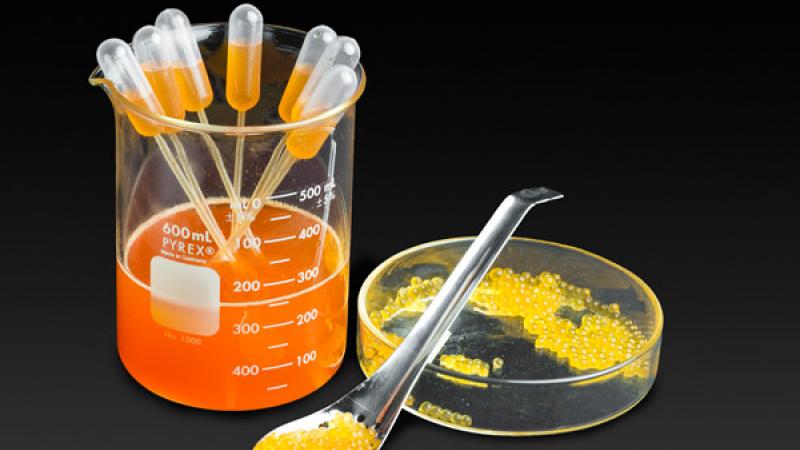- Spherification - Soda or Juice Caviar Recipe Reverse Spherification - Yogurt Ravioli Recipe Questions
matches /academics/bas/taste/spherification ... percision: 3 of
Ingredients
- 200 g. Fruit juice or soda
(ph above 3.7%) - 0.6 - 1.0 g. Sodium alginate
- 500 g. Tap water
- 1 g. Calcium chloride
- 6 fl. oz. Tap water as needed
Tools
- Stick blender, mixing tool
- Pipettes
- Spoons, slotted
- Bowls
- Tasting cups/spoons
Preparation
- Using a hand-held blender or mixing tool, mix the soda or flavored liquid and sodium alginate together. This will take longer than expected, 5-10 minutes. Let rest to remove any trapped air bubbles. For optimum solution, let rest overnight.
- Using the blender or mixing tool, combine 500 g. water and calcium chloride until fully mixed. For optimum solution, let rest in refrigerator overnight.
- Set up a spherification station: soda + sodium alginate mixture; calcium chloride bath; tap water rinse; and holding vessel.

- These are time sensitive. Use within 15 minutes for maximum effect.
Procedure
- Fill pipettes with the juice or soda and sodium alginate solution.
- Gently squeeze the pipettes (syringes or squeeze bottles could also work) to release the solution drop by drop into calcium chloride bath. Be careful not to drop the liquid from too great of a height or they will flatten and resemble small pancakes instead of caviar spheres.
- After you have dropped a small quantity into the bath, remove the spheres from the calcium chloride solution with a small slotted spoon.
- Blot the bottom of the spoon with a towel to remove the calcium chloride solution.
- Place spheres in the water rinsing bath.
- Immediately after rinsing, remove the spheres from the tap water and sample the results.
Ingredients
- 1500 g. Distilled water
- 7.5 g. Sodium alginate
- 200 g. Yogurt
- 4 g. Calcium lactate gluconate
- 250 ml. Tap water
Tools
- Stick blender, mixing tool
- Pipettes
- Spoons, slotted
- Bowls
- Tasting cups/spoons
Preparation
- Using a hand-held blender or mixing tool, mix the distilled water and sodium alginate together. This will take longer than expected, 5-10 minutes. Let rest to remove any trapped air bubbles. For optimum solution, let rest overnight. Use distilled water if the calcium content is high in your tap water.
- Mix the yogurt with calcium lactate gluconate to boost the calcium content.
- Set up the three-part station: Yogurt + calcium lactate gluconate mixture; sodium alginate bath; tap water rinse; and holding vessel.

Procedure
- Use a small spoon (a 1/2 teaspoon measure) and gently turn the spoon so the yogurt will enter the sodium alginate bath.
- Let the sphere sit in the solution for up to two minutes so the membrane will form. Make sure not to let the spheres touch each other or they will stick together.
- Remove the sphere with a slotted spoon; make sure the sodium alginate solution has drained from the spoon.
- Place the sphere in the water to rinse the salt byproduct.
- Sample or store in juice until ready to sample.
Questions
Originally it was created as a process for encapsulation in the drug industry for time-released medicines.
Both form layers around a liquid, but the reverse process allows for a liquid center that will remain liquid for a longer period of time and allows for a larger size.
The calcium alginate ions create the outer layer of the shell. The calcium ions are small enough to permeate the shell and continue to gradually turn the alginate liquid into a solid. The process of reverse spherification doesn’t behave the same way due to the fact that the alginate molecules are too large to diffuse through the calcium alginate shell. Spherification is time sensitive while reverse spherification is not. The overall theory is that of membrane diffusion.
- Spherification - Soda or Juice Caviar Recipe Reverse Spherification - Yogurt Ravioli Recipe Questions
matches /academics/bas/taste/spherification ... percision: 3 of


